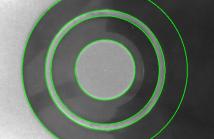- Read more about A Novel Variational Model for Retinex in Presence of Severe Noises
- Log in to post comments
Retinex theory deals with compensation for illumination effects in images, which is usually an ill-posed problem. The existence of noises may severely challenge the performance of Retinex algorithms. Therefore, the main aim of this paper is to present a general variational Retinex model to effectively and robustly restore images corrupted by both noises and intensity inhomogeneities. Our strategy is to simultaneously recover the noise-free image and decompose it into reflectance and illumination component.
- Categories:
 14 Views
14 Views- Read more about CONTRASTIVE-CENTER LOSS FOR DEEP NEURAL NETWORKS
- Log in to post comments
The deep convolutional neural network(CNN) has significantly raised the performance of image classification and face
- Categories:
 10 Views
10 Views- Read more about LOW-LIGHT IMAGE ENHANCEMENT USING CNN AND BRIGHT CHANNEL PRIOR
- Log in to post comments
Poster.pdf
- Categories:
 106 Views
106 Views- Read more about 360-degree Video Stitching for Dual-fisheye Lens Cameras Based On Rigid Moving Least Squares
- Log in to post comments
Dual-fisheye lens cameras are becoming popular for 360-degree video capture, especially for User-generated content (UGC), since they are affordable and portable. Images generated by the dual-fisheye cameras have limited overlap and hence require non-conventional stitching techniques to produce high-quality 360x180-degree panoramas. This paper introduces a novel method to align these images using interpolation grids based on rigid moving least squares. Furthermore, jitter is the critical issue arising when one applies the image-based stitching algorithms to video.
- Categories:
 285 Views
285 Views- Read more about 3-D Mean-Separation-Type Short-Time DFT with Its Application to Moving-Image Denoising
- Log in to post comments
Although for a still image the 2-D DFT and the 2-D DCT have similar properties to each other, for a moving-image sequence the 3-D DFT gets an advantage of representing the sequence more compactly over the 3-D DCT. Through the mathematical analysis of the 3-D DFT and the 3-D DCT based on a simple signal model of a moving-image sequence, this paper shows that the even symmetrization employed implicitly by the 3-D DCT may cause deterioration of representation efficiency and hence the 3-D DFT can achieve better representation efficiency than the 3-D DCT.
- Categories:
 8 Views
8 Views- Read more about A Directed Graph Approach to Active Contours
- Log in to post comments
Active contours based on level sets are popular segmentation algorithms but their local optimization approach makes their results to depend on initialization, especially for edge-based formulations. In this paper we present a novel energy minimization method based on directed graph optimization that minimizes the same type of active contour energy function without the need of an initialization.
- Categories:
 9 Views
9 ViewsWe look at the problem of developing a compact and accurate model for gesture recognition from videos in a deep-learning framework. Towards this we propose a joint 3DCNN-LSTM model that is end-to-end trainable and is shown to be better suited to capture the dynamic information in actions. The solution achieves close to state-of-the-art accuracy on the ChaLearn dataset, with only half the model size. We also explore ways to derive a much more compact representation in a knowledge distillation framework followed by model compression.
- Categories:
 8 Views
8 Views
- Read more about Circle Detection by Arc-support Line Segments
- Log in to post comments
Circle detection is fundamental in both object detection and high accuracy localization in visual control systems. We propose a novel method for circle detection by analysing and refining arc-support line segments. The key idea is to use line segment detector to extract the arc-support line segments which are likely to make up the circle, instead of all line segments. Each couple of line segments is analyzed to form a valid pair and followed by generating initial circle set.
- Categories:
 112 Views
112 Views- Read more about UNSUPERVISED DOMAIN ADAPTATION WITH JOINT SUPERVISED SPARSE CODING AND DISCRIMINATIVE REGULARIZATION TERM
- Log in to post comments
- Categories:
 9 Views
9 Views